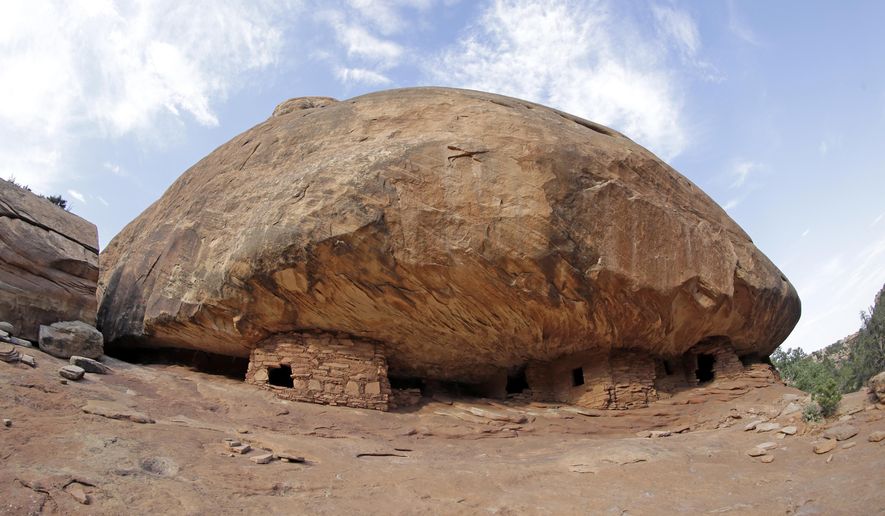The Trump administration is poised to nip the Bears Ears National Monument, beginning a rollback of one of President Obama’s most aggressive environmental moves.
Interior Secretary Ryan Zinke issued an interim report Monday saying the 1.35-million-acre Utah monument that Mr. Obama established on his way out of office is far too big and needs to be carved up and cut down to size.
It’s the first in what is likely to be a series of moves to reverse Mr. Obama’s aggressive use of presidential powers under the 1906 Antiquities Act to heighten federal control of public lands. The law says national monuments should use the “smallest area” possible — a requirement that Mr. Zinke says has been clearly violated by the sprawling Bears Ears monument.
“The recommendation is to revise the existing boundaries,” he told reporters on a conference call.
He did not say how much acreage would remain under formal monument protections, though he seemed to suggest that the status will be revoked for much of the land if Mr. Trump follows his suggestions. Mr. Zinke said two specific areas should remain national monuments: the area containing the Bears Ears geological formation and an area farther north that contains a “high density of archaeological sites.”
The land in the middle could still have some protections but would not be entirely shut off to energy exploration and other activities.
“The goal is to protect the historic and prehistoric structures, no doubt. It’s a little premature to throw out acreage, but if you look at Bears Ears as a whole, there’s a lot more drop-dead gorgeous land than there is historic landmarks, prehistoric structures, and other objects,” he said.
The initial report, which touched off a firestorm among environmentalists and spurred threats of litigation, is the first concrete step from the administration to end the practice of using monument designations to cordon off huge swaths of land. Monument status, among other things, closes off areas to coal mining, oil drilling, hunting and other activities.
During his time in office, Mr. Obama used national monuments to protect more land and sea than any of his predecessors, often establishing federal landmarks over the explicit objections of local stakeholders.
Mr. Zinke’s final report, due later this year, will examine another two dozen national monuments, including the Grand Staircase-Escalante National Monument in Utah established by President Clinton in 1996. Monuments in California, Maine and elsewhere across the country are also under review.
Critics immediately pounced on the recommendation, saying it confirmed what they suspected all along: that the monument review is simply a pretext for the administration to revoke monument protections and open federal land to coal mining and oil drilling.
“Zinke’s recommendation is a slap in the face to the tribes that sought protection for Bears Ears and any American who values our incredible public lands,” said Randi Spivak, public lands program director with the Center for Biological Diversity. “Sadly, this is yet another corrupt process from the Trump administration that ignores public sentiment and rewards polluting industries that view our public lands as simply another source of profit. … It’s time for Zinke to stop pretending he’s a Teddy Roosevelt kind of a guy. President Roosevelt would be ashamed of him.”
But the proposal, from a legal perspective, seems to be a shrewd move by the interior secretary. By shrinking Bears Ears rather than revoking its status entirely, the administration could avoid the kind of unprecedented legal challenge that scholars have said would be likely to end up before the Supreme Court.
The Antiquities Act does not give the president power to revoke an entire monument, but presidents have reduced the sizes of monuments, establishing a precedent for the administration.
About 20 national monuments have been reduced in size by past presidents, though their actions were never challenged in court. Most of those adjustments were small compared with the significant change proposed to Bears Ears.
With that in mind, environmentalists say they already are readying lawsuits.
“Bears Ears is a national treasure home to archaeological wonders, ancient cliff dwellings and special wild spaces, and the American people have said loud and clear that any effort to dismantle its protections as a political favor to a few disgruntled Utah politicians is unacceptable. If President Trump follows Secretary Zinke’s recommendation to shrink the boundaries of these cherished lands, we will see him in court,” said Heidi McIntosh, an attorney with the environmental group Earthjustice.
Mr. Zinke also said he would ask Congress to pass legislation setting up management bodies to oversee the monuments, a move that would effectively kill the Bears Ears Inter-Tribal Coalition established by the Obama administration when the monument was established in December. That coalition has been leading the charge to maintain Bears Ears in its current form.
The secretary said legislation should be able to clear the House within the next several months, though previous attempts to enact such a law have failed even with Republicans in control of Congress. Mr. Zinke said he believes things can be different with Mr. Trump in the White House.
Republican lawmakers said they support Mr. Zinke’s proposal and argue that a comprehensive redo of the entire Bears Ears site offers an opportunity to find true consensus.
“This is positive news for the state of Utah and local communities affected by the Bears Ears monument designation. Anyone with honest intentions recognizes that local input should matter when the federal executive makes a decision of this magnitude,” said Rep. Rob Bishop, Utah Republican and chairman of the House Natural Resources Committee.
• Ben Wolfgang can be reached at bwolfgang@washingtontimes.com.




Please read our comment policy before commenting.